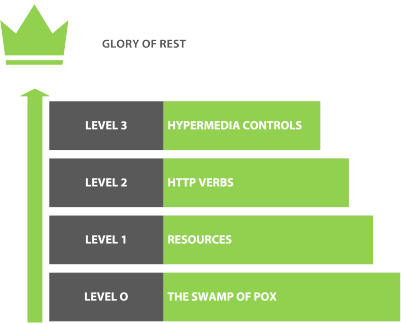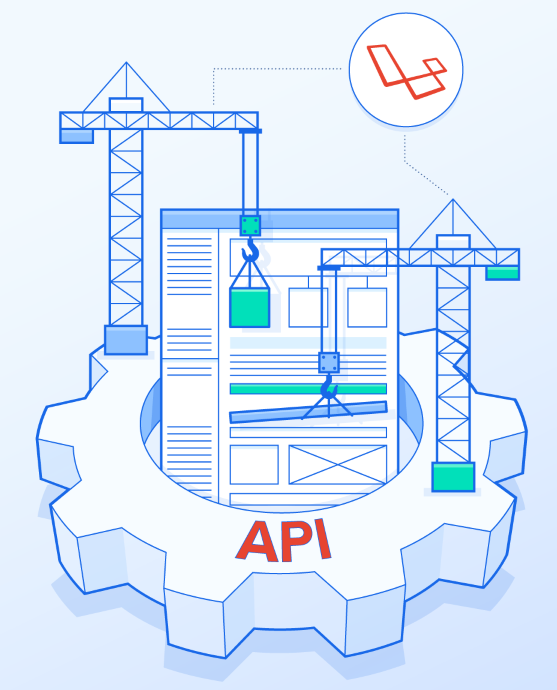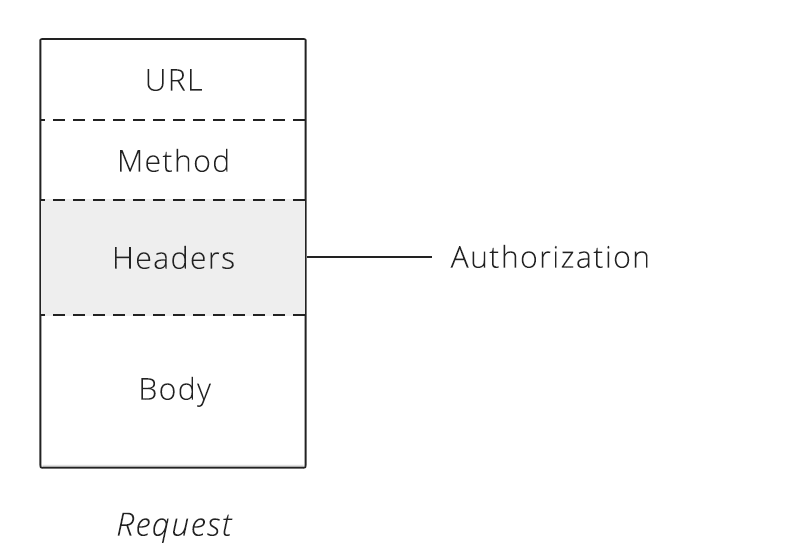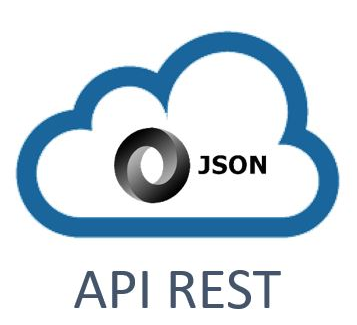If you are building REST APIs or REST Services you're using HTTP.
Technically, REST services can be provided over any application layer protocol as long as they conform to certain properties. In practice, basically, everyone uses HTTP Protocol.
Since we are discussing the creation of an API that conforms to REST rather than a system architecture based on the principles of REST, HTTP is a solid assumption.
Roy Fielding writes:
A REST API must not define fixed resource names or hierarchies (an obvious coupling of client and server). Servers must have the freedom to control their own namespace. Instead, allow servers to instruct clients on how to construct appropriate URIs, such as is done in HTML forms and URI templates, by defining those instructions within media types and link relations.
A REST API should be entered with no prior knowledge beyond the initial URI (bookmark) and set of standardized media types that are appropriate for the intended audience (i.e., expected to be understood by any client that might use the API). From that point on, all application state transitions must be driven by client selection of server-provided choices that are present in the received representations or implied by the user’s manipulation of those representations.
These concepts are closely related to the notion of "hypermedia controls". The basic idea is that a representation of an object should tell the client what it can do with the object or related actions that it might take. Such descriptions are called "hypermedia controls". The format used to present hypermedia controls is specified by the media type.
The Richardson REST Maturity Model describes four different levels of REST (starting at Level 0). A REST API that supports hypermedia controls is classified as Level 3 in this maturity model.
The levels of maturity according to Richardson’s model:

However, all these are discussing the REST API maturity level and not the design maturity level.
When discussing the REST API maturity level design we have to think about the following: Versioning, Actions, Errors, Pagination and more. I will try to go over the basic maturity levels and add a REST API design perspective. For more information on some of the rules please read these as well:
7 Rules for REST API URI Design
5 Basic REST API Design Guidelines
Level 0 - The Swamp of POX
The Swamp of POX (Plain Old XML) means that you’re using HTTP. Technically, REST services can be provided over any application layer protocol as long as they conform to certain properties. In practice, basically, everyone uses HTTP.
These services have a single URI and use a single HTTP method (typically POST). These are the most primitive way of building SOA applications with a single POST method and using XML to communicate between services.
Level zero of maturity does not make use of any of URI, HTTP Methods, and HATEOAS capabilities.
Even at level 0, there are many design rules that we need to consider:
Rule #1: Hyphens (-) should be used to improve the readability of URIs - Also referred to as spinal-case
To make your URIs easy for people to scan and interpret, use the hyphen (-) character to improve the readability of names in long path segments. Anywhere you would use a space or hyphen in English, you should use a hyphen in a URI.
For example:
http://api.example.com/blogs/guy-levin/posts/this-is-my-first-post
It is recommended to use spinal-case (which is highlighted by RFC 3986), this case is used by Google, PayPal, and other big companies.
Rule #2: Underscores (_) should not be used in URIs
Text viewer applications (browsers, editors, etc.) often underline URIs to provide a visual cue that they are clickable. Depending on the application’s font, the underscore (_) character can either get partially obscured or completely hidden by this underlining.
To avoid this confusion, use hyphens (-) instead of underscores
Rule #3: Lowercase letters should be preferred in URI paths
When convenient, lowercase letters are preferred in URI paths since capital letters can sometimes cause problems. RFC 3986 defines URIs as case-sensitive except for the scheme and host components.
For example:
http://api.example.com/my-folder/my-doc vs http://api.example.com/My-Folder/my-doc
Rule #4: File extensions should not be included in URIs
On the Web, the period (.) character is commonly used to separate the file name and extension portions of a URI.
A REST API should not include artificial file extensions in URIs to indicate the format of a message’s entity body. Instead, they should rely on the media type, as communicated through the Content-Type header, to determine how to process the body’s content.
http://api.college.com/student/3248234/course/2005/fall.json
http://api.college.com/student/3248234/course/2005/fall
Level 1 - Resources
REST’s ‘resources’ are the core pieces of data that your application acts on. These will often correspond to the Models in your application (especially if you’re following the MVC - model, view, controller pattern).
API design at Level 1 is all about using different URLs to interact with the different resources in your application.
First, I would like to clarify that using verbs in URI which is bad practice and I write then next only to demonstrate a point and to ease the way into the resources properly usage.
Let’s write few APIs for Blog which has some articles, to understand more. /getAllArticles is an API which will respond with the list of articles.
Few more APIs around a Blog will look like as follows:/addNewArticle/updateArticle/deleteArticle/deleteAllArticle/promoteArticle/promoteAllArticle

There are a set of common operations that are performed on resources, and it seems kinda silly to make a new URI for every operation, especially when they’re shared - That is where Level 2 comes in.
Even at this level, there are a few design rules that worth to remember:
Rule #1: A trailing forward-slash (/) should not be included in URIs
This is one the most important rules to follow as the last character within a URI’s path, a forward slash (/) adds no semantic value and may cause confusion. REST API’s should not expect a trailing slash and should not include them in the links that they provide to clients.
http://api.canvas.com/shape/
http://api.canvas.com/shape
Every character within a URI counts toward a resource’s unique identity.
Two different URIs map to two different resources.
Rule #2: Forward slash separator (/) must be used to indicate a hierarchical relationship
The forward-slash (/) character is used in the path portion of the URI to indicate a hierarchical relationship between resources.
For example:
http://api.canvas.com/shapes/polygons/quadrilaterals/squares
Rule #3: Should the endpoint name be singular or plural? The keep-it-simple rule applies here. Although your inner-grammatician will tell you it's wrong to describe a single instance of a resource using a plural, the pragmatic answer is to keep the URI format consistent and always use either plural or singular.
Not having to deal with odd pluralization (person/people, goose/geese) makes the life of the API consumer better and is easier for the API provider to implement (as most modern frameworks will natively handle /students and /students/3248234 under a common controller).
I personally like to use the singular way since for me, using it like GET /person and GET /person/{ID}, the first one means a search for a person without any ID which means - return every person and the second one is searching a person with a given ID. One more thing to consider is that when we talk about Resources in APIs, it is mostly a Resource (single) that is being manipulated - as you will see later on in the methods table, even if we say collection - it is not collections. But you are more than welcome to use either one, plural or singular, at your own choice - just be consistent!
Level 2 - Methods
We are always going to need to perform CRUD operations on our resources, so why not find a way to share these operations across resources? Why create a new resource for each action or operation we would like to perform?
We accomplish this using HTTP Verbs. If we want to get a list of Pages, we make a GET request to /page, but if we want to create a new Page, we use POST rather than GET to the same resource - /page.
Here is the common Methods / Actions used:
| Method | Scope | Semantics |
|---|---|---|
| GET | collection | Retrieve all resources in a collection |
| GET | resource | Retrieve a single resource |
| HEAD | collection | Retrieve all resources in a collection (header only) |
| HEAD | resource | Retrieve a single resource (header only) |
| POST | collection | Create a new resource in a collection |
| PUT | resource | Update a resource |
| PATCH | resource | Update a resource |
| DELETE | resource | Delete a resource |
| OPTIONS | any | Return available HTTP methods and other options |
Actions
Sometimes, it is required to expose an operation in the API that inherently is non-RESTful. One example of such an operation is where you want to introduce a state change for a resource, but there are multiple ways in which the same final state can be achieved, and those ways actually differ in a significant but non-observable side-effect.
Some may say such transitions are bad API design, but not having to model all state can greatly simplify an API.
As a solution to such non-RESTful operations, an “actions” sub-collection can be used on a resource. Actions are basically RPC-like messages to a resource to perform a certain operation. The “actions” sub-collection can be seen as a command queue to which new action can be POSTed, that are then executed by the API. Each action resource that is POSTed, should have a “type” attribute that indicates the type of action to be performed and can have arbitrary other attributes that parameterize the operation.
It should be noted that actions should only be used as an exception when there’s a good reason that an operation cannot be mapped to one of the standard RESTful methods.
Level 2.1 - HTTP headers
The HTTP headers are one of the basic design rules for REST APIs. They are needed in order to convey more data about the resource itself, mostly meta-data, security, hashes and more.

HTTP headers also provide the required information about the request or response, or as we said - about the object sent in the message body.
There are 4 types of HTTP message headers:
General Header These header fields have general applicability for both request and response messages.
Client Request Header These header fields have applicability only for request messages.
Server Response Header These header fields have applicability only for response messages.
Entity Header These header fields define meta information about the entity-body or, if no BODY is present, about the resource identified by the request.
Level 2.2 - Query Parameters
Another important part of REST API design is using query parameters.
They are widely used in many cases but it is more likely that they are used in order to achieve some sort of searching, filtering, and querying.
Paging It is necessary to anticipate the paging of your resources in the early design phase of your API. It is indeed difficult to foresee precisely the progression of the amount of data that will be returned. Therefore, we recommend paginating your resources with default values when they are not provided by the calling client, for example with a range of values [0-25].
Filtering Filtering consists in restricting the number of queried resources by specifying some attributes and their expected values. It is possible to filter a collection on several attributes at the same time and to allow several values for one filtered attribute.
Sorting Sorting the result of a query on a collection of resources. A sort parameter should contain the names of the attributes on which the sorting is performed, separated by a comma.
Searching A search is a sub-resource of a collection. As such, its results will have a different format than the resources and the collection itself. This allows us to add suggestions, corrections, and information related to the search.
Level 2.3 - Status Codes
It is very important that as a RESTful API, you make use of the proper HTTP Status Codes, especially when developing and mocking RESTful API.
The mostly used status codes:
200 – OK
Everything is working
201 – CREATED
A new resource has been created
204 – NO CONTENT
The resource was successfully deleted, no response body
304 – NOT MODIFIED
The date returned is cached data (data has not changed)
400 – BAD REQUEST
The request was invalid or cannot be served. The exact error should be explained in the error payload. E.g. „The JSON is not valid “.
401 – UNAUTHORIZED
The request requires user authentication.
403 – FORBIDDEN
The server understood the request but is refusing it or the access is not allowed.
404 – NOT FOUND
There is no resource behind the URI.
500 – INTERNAL SERVER ERROR
API developers should avoid this error. If an error occurs in the global catch blog, the stack trace should be logged and not returned as a response.
Level 3 - Hypermedia Controls
This level is the one that everyone falls down on. There are two parts to this: content negotiation and HATEOAS. Content negotiation is focused on different representations of a particular resource, and HATEOAS is about the discoverability of actions on a resource.
Content Negotiation
Generally, resources can have multiple presentations, mostly because there may be multiple different clients expecting different representations. Asking for a suitable presentation by a client is referred to as content negotiation.
HTTP has provisions for several mechanisms for “content negotiation” — the process of selecting the best representation for a given response when there are multiple representations available.

Content Negotiation is performed by an application:
To match the requested representation as specified by the client via the Accept header with a representation the application can deliver.
To determine the Content-Type of incoming data and deserialize it so the application can utilize it.
Essentially, content negotiation is the client telling the server what it is sending and what it wants in return, and the server determining if it can do what the client requests.
Accept Negotiation
The first aspect of content negotiation is handling the Accept header. The Accept header has one of the most complex definitions in the HTTP specification. With supplying this header in the request, a client can indicate a prioritized list of different media types that it will accept as responses from the server.
In practice, particularly with APIs, you will send a specific media type for the representation you can handle in your client. As an example:
GET /foo HTTP/1.1
Accept: application/json
The above indicates that the client wants JSON for a response. It is now the server's responsibility to determine if it can return that representation.
If the server can not return JSON, it needs to tell the client that fact. This is done via the 406 Not Acceptable status code:
HTTP/1.1 406 Not Acceptable
Ideally, the server will also indicate what media types it can return; however, it is not obligated to do so.
Because the server cannot return a representation for the requested media type, it can choose whatever media type it wants for the response in order to communicate errors.
If the server can return the requested media type, it should report the media type via the response Content-Type header.
One important point of interest: the same URI can potentially respond with multiple media types. This means that you could potentially make one request that specifies text/html, another with application/json, and get different representations of the same resource!
This is a very important aspect of content negotiation; one of the purposes is to allow many clients to the same resource, speaking in different protocols.
Content-Type Negotiation
The second aspect of content negotiation is identifying the incoming Content-Type header and determining if the server can deserialize that data.
As an example, the client might send the following:
POST /foo HTTP/1.1
Accept: application/json
Content-Type: application/json
{
"foo": "bar"
}
The server would introspect the Content-Type header and determine that JSON was submitted. Now it has to decide if it can deserialize that content. If it cannot, the server will respond with a 415 Unsupported Media Type status code:
HTTP/1.1 415 Unsupported Media Type
If the data submitted is not actually of the Content-Type specified, meaning it cannot be deserialized properly, the server will typically respond with a generic 400 Bad Request status.
HATEOAS
Hypermedia As Transfer Engine Of Application State is a constraint of the REST application architecture that distinguishes it from other network application architectures.
It provides ease of navigation through a resource and its available actions. This way a client doesn’t need to know how to interact with an application for different actions, as all the metadata will be embedded in responses from the server.
To understand it better let’s look at the below response of retrieve user with id 123 from the server:
{
"name": "John Doe",
"links": [{
"rel": "self",
"href": "http://localhost:8080/user/123"
},
{
"rel": "posts",
"href": "http://localhost:8080/user/123/post"
},
{
"rel": "address",
"href": "http://localhost:8080/user/123/address"
}
]
}
Sometimes it’s easier to skip the links format, and specify links as fields of a resource as below:
{
"name": "John Doe",
"self": "http://localhost:8080/user/123",
"posts": "http://localhost:8080/user/123",
"address": "http://localhost:8080/user/123/address"
}
It’s not a convention you need to follow every time, as it depends on resource fields/size, and actions which can be performed on a resource. If resources contain several fields that the user may not want to go through, it’s a good idea to show navigation to sub-resources then implement HATEOAS.
3.1 - Versioning
I have decided to include the versioning design here since REST API versioning is a much more mature REST API model and for the reason that Content negotiation is focused on different representations of a particular resource, versioning can be called as a different representation of a resource.
Versioning APIs always helps to ensure backward compatibility of a service while adding new features or updating existing functionality for new clients.
There are different schools of thought to version your API, but most of them fall under two categories below:
Headers:
There are 2 ways you can specify the version in headers:
Custom Header:
Adding a custom X-API-VERSION (or any other header of choice) header key by the client can be used by a service to route a request to the correct endpoint
Accept Header
Using accept header to specify your version such as
Accept: application/vnd.hashmapinc.v2+json
URL:
Embed the version in the URL such as
POST /v2/user
I prefer to use the URL method for versioning as it gives better discoverability of a resource by looking at the URL.
Summary
In this article, I have tried to reflect the REST API design rules on the Richardson Maturity Model for REST API's. There are many talks about the 4 levels of REST API maturity, however they are not complete in my opinion as they are only showing usages of Resources, Methods, and Content Negotiation / HATEOAS but they are not saying anything about the usages of HTTP Headers, Status Codes, Query parameters, and other REST API design aspects.